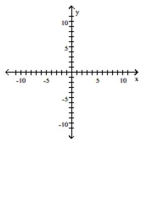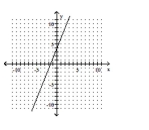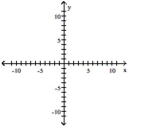A)
B)
C)
D)
F) A) and C)
Correct Answer

verified
Correct Answer
verified
Multiple Choice
Solve the inequality by using algebraic and graphical methods. Round to three decimal places, if necessary. -
A) or
B)
C)
D)
F) B) and D)
Correct Answer

verified
Correct Answer
verified
Multiple Choice
The volume of a cylinder whose height is equal to twice its radius is , where x is the radius of the cylinder in cm . Find the inverse of this function.
A)
B)
C)
D)
F) B) and D)
Correct Answer

verified
Correct Answer
verified
Multiple Choice
Decide whether or not the functions are inverses of each other. -
A) Yes
B) No
D) undefined
Correct Answer

verified
Correct Answer
verified
Multiple Choice
The graph of is shifted 4 units to the right.
A)
B)
C)
D)
F) All of the above
Correct Answer

verified
Correct Answer
verified
Multiple Choice
Sketch the graph of the pair of functions. Use a dashed line for g(x)
-

A) ![]()
B) ![]()
C) ![]()
D) ![]()
F) None of the above
Correct Answer

verified
Correct Answer
verified
Multiple Choice
The graph of the function y . Use a dashed line for the inverse
function.
-
A) ![]()
B) ![]()
C) ![]()
D) ![]()
F) A) and C)
Correct Answer

verified
Correct Answer
verified
Multiple Choice
Find the specified domain and express it in interval notation. -If f(x) =2x+10 and g(x) =x2+3 , evaluate .
A)
B) 2
C) 98
D) 21
F) None of the above
Correct Answer

verified
Correct Answer
verified
Multiple Choice
Sketch the graph of the pair of functions. Use a dashed line for g(x)
-

A) ![]()
B) ![]()
C) ![]()
D) ![]()
F) A) and C)
Correct Answer

verified
Correct Answer
verified
Multiple Choice
Find the specified domain and express it in interval notation. -If f(x) =3 x+4 and g(x) =x-x2 , evaluate (f+g) (3) .
A) 6
B) 19
C) 7
D) -78
F) B) and D)
Correct Answer

verified
Correct Answer
verified
Multiple Choice
Determine whether the graph of the given equation is symmetric with respect to the x-axis, the y-axis, and/or the origin. -
A) No symmetry
B) Origin
C) x-axis
D) y-axis
F) B) and D)
Correct Answer

verified
Correct Answer
verified
Multiple Choice
Graph the given function as a solid line (or curve) and its inverse as a dashed line (or curve) on the same set of axes.
-

A) ![]()
B) ![]()
C) ![]()
D) ![]()
F) B) and C)
Correct Answer

verified
Correct Answer
verified
Multiple Choice
Use the quadratic formula or graphing methods to -
A)
B)
C)
D) or
F) B) and D)
Correct Answer

verified
Correct Answer
verified
Multiple Choice
Use the quadratic formula or graphing methods to -
A)
B)
C)
D) or
F) C) and D)
Correct Answer

verified
Correct Answer
verified
Multiple Choice
Aretailer that n games can be sold in a month at a price of 20-0.1n dollars per game. Assume that he buys each game for $13, and sells every one that he buys. if he whishes to make a profit of at least $100 per month on sales of this game, how many games must he sell each month?
A)
B)
C)
D)
F) C) and D)
Correct Answer

verified
Correct Answer
verified
Multiple Choice
The graph of the function y . Use a dashed line for the inverse function. -A size 4 dress in Country C is size 42 in Country D. A function that converts dress sizes in Country to those in Country is . Find a formula for the inverse of this function.
A)
B)
C)
D)
F) B) and C)
Correct Answer

verified
Correct Answer
verified
Multiple Choice
Solve the equation -
A) x=14
B) x=9
C) x=6
D) x=12
F) A) and C)
Correct Answer

verified
Correct Answer
verified
Multiple Choice
Determine whether the graph of the given equation is symmetric with respect to the x-axis, the y-axis, and/or the origin. -
A) x -axis
B) y -axis
C) No symmetry
D) Origin
F) B) and C)
Correct Answer

verified
Correct Answer
verified
Multiple Choice
For the pair of functions, perform the indicated operation. - Find
A)
B)
C)
D)
F) A) and C)
Correct Answer

verified
Correct Answer
verified
Multiple Choice
Determine whether or not the function is one-to-one.
-
A) Yes
B) No
D) undefined
Correct Answer

verified
Correct Answer
verified
Showing 241 - 260 of 299
Related Exams